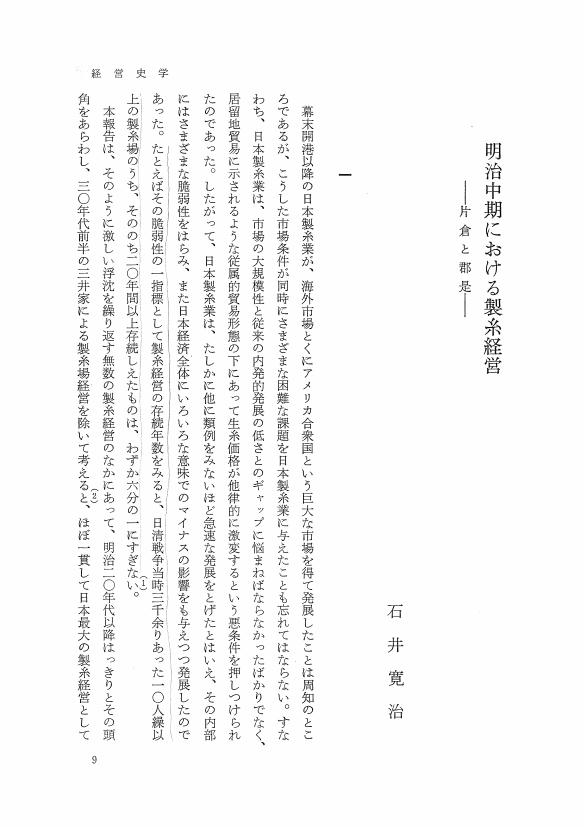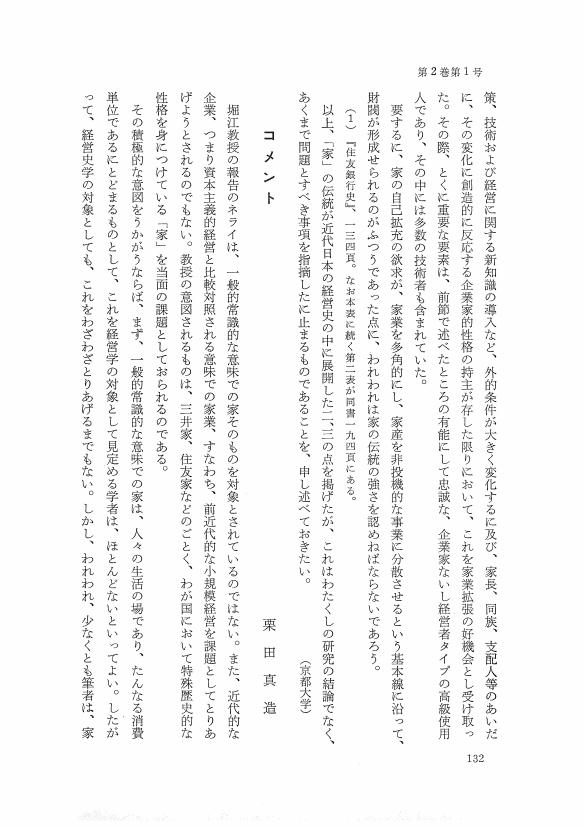1 0 0 0 OA 企業者活動の国際比較
- 出版者
- 経営史学会
- 雑誌
- 経営史学 (ISSN:03869113)
- 巻号頁・発行日
- vol.4, no.1, pp.84-101, 1969-01-26 (Released:2009-11-11)
1 0 0 0 OA コメント4
- 著者
- 中川 敬一郎
- 出版者
- 経営史学会
- 雑誌
- 経営史学 (ISSN:03869113)
- 巻号頁・発行日
- vol.3, no.1, pp.105-107, 1968-03-15 (Released:2009-11-11)
1 0 0 0 OA わが国近代企業定着期における経営的諸問題
- 出版者
- 経営史学会
- 雑誌
- 経営史学 (ISSN:03869113)
- 巻号頁・発行日
- vol.3, no.1, pp.108-122, 1968-03-15 (Released:2009-11-11)
1 0 0 0 OA 「家造りらの捨てた石」
- 著者
- コール アーサー
- 出版者
- 経営史学会
- 雑誌
- 経営史学 (ISSN:03869113)
- 巻号頁・発行日
- vol.3, no.2, pp.1-24, 1968-07-30 (Released:2009-11-11)
- 参考文献数
- 26
- 被引用文献数
- 1
The author emphasizes the need for the studies in “meso-economics, ” a new field of the research concerning entrepreneurship. The other-supporting institutional relations which lie between the economic development and entrepreneurship have been discarded by both macro-and micro-economics. But the development of such a business system, or “structural innovation” is considered by the author to be a primary source for economic development. A full text in English of this paper will be published in Tradition, the German journal of business history.
1 0 0 0 OA 米国自動車産業経営史の一断面
- 著者
- 下川 浩一
- 出版者
- 経営史学会
- 雑誌
- 経営史学 (ISSN:03869113)
- 巻号頁・発行日
- vol.3, no.2, pp.25-59, 1968-07-30 (Released:2009-11-11)
- 参考文献数
- 39
During the 1920' s, the structure of the American automobile market changed from that of a simple growth market to that of a replacement market. An examination of that period has some importance to the business history of the American automobile industry. This article will point out some of the characteristics of the structure of the American automobile industry in the twenties. Model changes were regularized during this period through a transformation of the market structure. Competitiveness in market shares was achieved by big firms through improvements in the efficiency of passenger cars and through the establishment of a demand-sliding schedule. Third, the demand for automobiles was saturated after 1925 and the automobile industry was chronically in a state of oversupply, thus investment was financed exclusively from retained profits.During the twenties, Ford and GM developed contrasting managerial policies. Ford was able to reduce the production costs significantly by a technological rationalization of assembly processes, while GM adopted a decentralized managerial scheme to deal with changes in the market structure. After 1925, GM succeeded in surpassing Ford in the production of automobiles. GM also had a superior system of financial controls, and was ready for an administered pricing system, by means of objective rates of return and standard volumes.Finally, the twenties were a turning point for the American automobile industry. During this period, price competition was severe, preventing the establishment of a monopolistic control. New managerial techniques were adopted to develop advanced marketing and pricing policies geared to perpetual model changes. Thus the twenties may be regarded as preparatory to the oligopolistic era of the thirties.
1 0 0 0 OA フランスにおける経営史研究の動向 一九世紀銀行経営史と冶金工業史の文献を中心にして
- 著者
- 遠藤 輝明
- 出版者
- 経営史学会
- 雑誌
- 経営史学 (ISSN:03869113)
- 巻号頁・発行日
- vol.3, no.2, pp.60-82, 1968-07-30 (Released:2009-11-11)
- 参考文献数
- 23
Prof. D. S. Landes and other American scholars who did pioneering research on French business history studied the reasons for the economic stagnation of France since the turn of the century. They discovered that most of the business enterprises in France were family-owned, small in scale, and managed conservatively.By contrast, Prof. B. Gille and other French business historians emphasized the success of national economic planning since the end of the World War II, and tried to make it clear that the economic development in this period stemmed from various phenomena of the late 19th century : the corporation system, the joint-stock deposit and investment banks, and the technological innovations in the steel industry. For the purpose of clarifying contributions of 19th century entrepreneurs to the economic development in France, French scholars have published two journals, Histoire des Enterprises and Revue d'Histoire de la Siderurgie.The author reviewed the papers appearing in the above two journals, and outlined the development of the banking and the steel-making businesses in France.
1 0 0 0 OA 現代中国の経営管理
- 著者
- 楊 天溢
- 出版者
- 経営史学会
- 雑誌
- 経営史学 (ISSN:03869113)
- 巻号頁・発行日
- vol.3, no.2, pp.83-93, 1968-07-30 (Released:2009-11-11)
1 0 0 0 OA 石油産業における技術革新
- 著者
- 岩田 龍子
- 出版者
- 経営史学会
- 雑誌
- 経営史学 (ISSN:03869113)
- 巻号頁・発行日
- vol.3, no.2, pp.94-101, 1968-07-30 (Released:2009-11-11)
1 0 0 0 OA 三井財閥形成過程における有限責任制
- 著者
- 安岡 重明
- 出版者
- 経営史学会
- 雑誌
- 経営史学 (ISSN:03869113)
- 巻号頁・発行日
- vol.3, no.3, pp.1-27, 1968-12-20 (Released:2009-11-11)
- 参考文献数
- 40
- 被引用文献数
- 1
The limited liability system of all partners was permitted in Japan first by the Bank of Issue Act (Kokuritsu-Ginko Jorei) of 1872. Business Companies in general started to adopt the limited liability system when the first Commercial Law was enforced in 1893, and the joint-stock company with limited liability in its strict sense was not materialized until the amendment of the Commercial Law in 1899. Before then, however, the House of Mitsui had managed to introduce into its subsidiaries the effect of limited liability system by making full use of the Family Registration Law, and tried to avoid the unlimited responsibility for its subsidiaries.In this article I tried to elucidate these elaborate means and make it clear that the primary objective of the reorganization in 1909 of the Mitsuis subsidiaries on the basis of joint-stock system was not the establishment of limited liability but was rather the rationalization of management in its own way.
1 0 0 0 OA 小野組深山田製糸場の経営 -外国機械移植の一側面-
- 著者
- 中村 秀子
- 出版者
- 経営史学会
- 雑誌
- 経営史学 (ISSN:03869113)
- 巻号頁・発行日
- vol.2, no.3, pp.38-68,iv, 1967-11-15 (Released:2009-11-11)
Raw silk was one of the major items of Japanese export at the beginning of Meiji period and the Italian and French machines were introduced into Japan for the purpose of modernizing the silk reeling industry. The Ono Company started to operate a large scale reeling machines of Italian type at its Miyamada Works in 1872. But on account of the lack of skill needed for handling the sophisticated machine, the output was small and the cost of production was inevitably quite high. Unstable supply of cocoon was another source of trouble for the Miyamada Works which eventually fell into financial difficulties in 1874.Almost all the silk reeling works of Western model had to suffer the same kind of difficulties. But the cotton industry, another textile industry that had introduced foreign machines aggressively almost from England, had achieved a brilliant success in establishing modern mills which were sufficiently competitive in international market. What was the reason for this difference between the two textile industries?
1 0 0 0 OA 西ドイツにおける二つの話題 -カール・ツァイス財団とトロイエ教授-
- 著者
- 栗田 真造
- 出版者
- 経営史学会
- 雑誌
- 経営史学 (ISSN:03869113)
- 巻号頁・発行日
- vol.2, no.3, pp.69, 1967-11-15 (Released:2009-11-11)
1 0 0 0 OA わが国近代企業定着期における経営的諸問題 問題提起
- 著者
- 山口 和雄
- 出版者
- 経営史学会
- 雑誌
- 経営史学 (ISSN:03869113)
- 巻号頁・発行日
- vol.3, no.1, pp.1-8, 1968-03-15 (Released:2009-11-11)
- 被引用文献数
- 1
All of the papers published in this number were read at the third annual conference of the Business History Society of Japan which was held at Waseda University on the 20th of November, 1967.In the opening address, Kazuo Yamaguchi emphasized the extent of the competition the western-style enterprises in Japan had to fight with foreigners before they were firmly established by the beginning of the 20th century, and he pointed out the six conditions required for their effective competition in the world market.The second speaker, Kanji Ishii, of the University of Tokyo, explained that there were two types of silk-reeling mills, the mills which produced the common grade of raw silk and the mills which specialized in fine raw silk, both being exported for the American market.He also emphasized that the patterns of behavior of the two mills, the Katakura of the former type and the Gunze of the latter, were quite different in financing, purchasing, and labor recruitment. The commentator, Naosuke Takamura of Yokohama National University, raised the question whether these two types were not related to the two different stages of development of the Japanese silk-reeling industry.Yoichiro Inoue of Hiroshima University followed the technological development of the Nagasaki Shipyard of the Mitsubishi Co. and concluded that the prosperity of the Nagasaki Shipyard was based on its technical superiority over the competitive yards. Shigeaki Yasuoka of Doshisha University commented that the technical aspect should have been discussed in closer relation with other management factors.Tsunehiko Yui, of Meiji University, reported on the Tokyo Marine Insurance Co. formed by Eiichi Shibuzawa and subscribed by some aristocrats, mostly former daimyos. He emphasized the role of Kenkichi Kagami, who led the company successfully through a number of difficulties, devising an effective method of calculation and skillfully exploring the world market.Toshimitsu Imuta of Osaka Municipal University suggested that the success of Tokyo Marine Insurance should also be considered in relation to the development of industrial enterprises, to the cooperation among the competitive insurance companies and finally to the generous government subsidies. The final reporter, Yoshio Togai of Senshu University, traced in detail various challenges the Mitsui Trading Co. had to respond to in its formative years.Keiichiro Nakagawa of Tokyo University asked for further clarification of the competitive situation between the general and specialized merchants on the one hand and between the shipping, insurance and/or foreign exchange functions of those general merchants and the same kind of subsidiary businesses operated by independent firms on the other.
1 0 0 0 OA 明治中期における製糸経営 片倉と郡是
- 著者
- 石井 寛治
- 出版者
- 経営史学会
- 雑誌
- 経営史学 (ISSN:03869113)
- 巻号頁・発行日
- vol.3, no.1, pp.9-27, 1968-03-15 (Released:2009-11-11)
- 参考文献数
- 25
1 0 0 0 OA コメント1
- 著者
- 高村 直助
- 出版者
- 経営史学会
- 雑誌
- 経営史学 (ISSN:03869113)
- 巻号頁・発行日
- vol.3, no.1, pp.27-32, 1968-03-15 (Released:2009-11-11)
1 0 0 0 OA 日本近代造船業確立期における三菱長崎造船所
- 著者
- 井上 洋一郎
- 出版者
- 経営史学会
- 雑誌
- 経営史学 (ISSN:03869113)
- 巻号頁・発行日
- vol.3, no.1, pp.33-50, 1968-03-15 (Released:2009-11-11)
1 0 0 0 OA コメント2
- 著者
- 安岡 重明
- 出版者
- 経営史学会
- 雑誌
- 経営史学 (ISSN:03869113)
- 巻号頁・発行日
- vol.3, no.1, pp.50-53, 1968-03-15 (Released:2009-11-11)
1 0 0 0 OA 海上保険業の創業と確立 東京海上保険会社の場合
- 著者
- 由井 常彦
- 出版者
- 経営史学会
- 雑誌
- 経営史学 (ISSN:03869113)
- 巻号頁・発行日
- vol.3, no.1, pp.54-66, 1968-03-15 (Released:2009-11-11)
1 0 0 0 OA コメント3
- 著者
- 伊牟田 敏充
- 出版者
- 経営史学会
- 雑誌
- 経営史学 (ISSN:03869113)
- 巻号頁・発行日
- vol.3, no.1, pp.66-71, 1968-03-15 (Released:2009-11-11)
1 0 0 0 OA コメント5
- 著者
- 栗田 真造
- 出版者
- 経営史学会
- 雑誌
- 経営史学 (ISSN:03869113)
- 巻号頁・発行日
- vol.2, no.1, pp.132-135, 1967-07-30 (Released:2009-11-11)
1 0 0 0 OA ビジネス・システムと経済発展
- 出版者
- 経営史学会
- 雑誌
- 経営史学 (ISSN:03869113)
- 巻号頁・発行日
- vol.2, no.1, pp.136-169, 1967-07-30 (Released:2009-11-11)













